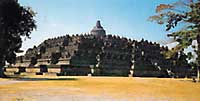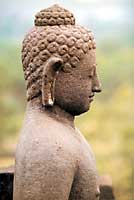|
|
||||
|
In ancient times, many ascetics, lamas and yogis dedicated their lives to achieving inner peace and self-awareness. To do this they renounced worldly distractions and lead quiet and simple lives meditating in the mountains and forests. One of the great centres of this self-healing activity was the Borobudur Stupa Mandala of Central Java, Indonesia, the second biggest buddhist monument that remains in the world (the first is Angkor Wat in Cambodia). Borobudur is a sacred power place for Tantric Buddhists, as it is built on one of the sites where Lord Buddha, 2,500 years ago, gave the Kalachakra or «Wheel of Time» tantric teachings. The Kalachakra teachings were then taken from Borobudur by King Suchandra to his Kingdom of Shambala in Central Asia, (now possibly in a region of the Gobi desert in Mongolia). The people of Shambala practiced these teachings purely and, as a result, raised their collective consciousness to such a high degree that the entire kingdom dematerialized into a subtler and purer astral dimension. As Shambala is no longer visible to ordinary people, many now think it is just a legend. However, there exists a subtle road from our world into the dimension of Shambala. The beginning of this road is found within the Borobudur Stupa Mandala. However, if we want to go to Shambala, just visiting Borobudur is not enough, we need a special wisdom key that alters our perception and thereby unlocks its secrets. This wisdom key is the Tantric Self-Healing practice created by T.Y.S. Lama Gangchen, who has a karmic connection to the mysteries of Borobudur since many lives. Through relating the thirteen stages of the Tantric Self-Healing practice to the thirteen levels of the Borobudur Stupa Mandala we can understand how to reactivate our Shambala energy. As we physically progress upwards, through the different levels of the Stupa-Mandala we purify our consciousness and begin to see the whole mandala as a representation of Shambala. After we reach the «mother stupa» at the top of the mandala, which symbolizes the attainment of enlightenment, we need to descend back to the ground which symbolizes bringing the Shambala energy into society. By opening our own minds, we can bring the Shambala energy into modern society, creating peace, awareness and healing for ourselves and the environment. According to Buddha’s prophecy, three hundred years from now when the energies of our planet have totally degenerated, the spiritually evolved beings from Shambala will return to this world and transform the planetary situation; saving us from destruction. In reality we do not need to wait for this to happen, we can begin this process of transformation right now by generating and integrating the positive Shambala energies into our daily life. This year, Lama Ganghen will be guiding the 12th annual Self-Healing retreat at Borobudur from the 5th to the 14th of December. As in the previous years we will deepen our awareness of the relationship between self-healing and the Borobudur mandala, but in particular this year we will deepen our experience of the divine feminine energy, which is represented over five hundred times around the monument in the form of the mother buddhas. Specifically the practice of Tara Chittamani will be introduced which helps us to overcome all the internal and external fears we face in daily life. Tara was, in fact, a princess called Wisdom Moon who lived in ancient India. She was very interested in spiritual practice and so she turned to the monks of her father’s court for advice. Condescendingly, they told her that getting enlightened was only possible if you were a man, and that she would have to wait for another life if she wanted to fulfil her spiritual ambitions. She stamped her foot and vowed to achieve enlightenment as a woman, which finally she did. She became Tara, the Liberator. During the retreat we will also learn about the body mandala practice of Tara which has a special power to heal suffering. This year, will also see the introduction of the Chod or ego cutting practice which was founded in the 11th century by a Tibetan yogini called Machig Labdron. This practice is basically a shamanistic psychodrama, chanted in Tibetan to the accompaniment of drumming, which helps us to rapidly connect with our inner feminine peace space, as well as strengthening our sense of ecological interpendence and love and compassion for all beings. Work will also continue with the divine masculine energies through the Diamond Hero Heruka practice written in the fourteenth century by Panchen Zangpo Tashi, one of Lama Gangchen’s more notable previous lives. Zangpo Tashi was the second Abbot of Tashi Lhumpo Monastery in western Tibet, as well as the founder of the newly reconstructed Gangchen Chopel Monastery in Gangchen near Shigatse. Everyone is welcome to participate in the retreat. Caroline Gammon |
||||
|
|
||||



